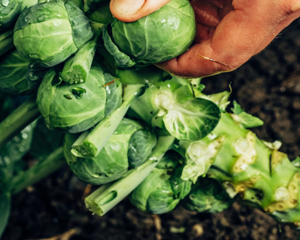As families gather around the table this holiday season, many will eagerly fill their plate with proteins, grains, and of course, desserts.
當這個假日季家人圍坐在餐桌旁時,許多人會急切地在盤子里裝滿蛋白質、谷物,當然還有甜點。
Vegetables are often a harder sell, especially the more bitter variety known as brassicas, a category that includes kale, mustard greens, brussels sprouts, and broccoli.
蔬菜通常很難推銷,尤其是被稱為蕓苔屬的較苦的品種,這一類包括羽衣甘藍、芥菜、球芽甘藍和西蘭花。
Some turn up their noses at tart fruits, as well.
有些人也會對酸水果嗤之以鼻。
In recent years, the aversion to eating bitter or pungent produce has prompted scientists to step up efforts to tweak the plants' DNA to reduce the enzymes that trigger these tastes.
近年來,人們對吃苦味或辛辣農產品的厭惡,促使科學家加緊努力調整植物的DNA,以減少引發這些味道的酵素。
The result are less bitter mustard greens, sweeter pineapples, and other crop varieties that have recently entered the marketplace or are about to.
結果是芥菜的苦味減少,鳳梨和其他最近進入或即將進入市場的農作物品種變得更甜。
But while alterations like these increase the produces' popularity, they also diminish their healthful effects.
雖然這樣的改變提高了產品的受歡迎程度,但也削弱了它們的健康作用。
The compounds that create the biting flavors of brassica vegetables are what make them so beneficial, says Michael Miller, a food scientist at the University of Illinois at Urbana-Champaign.
伊利諾伊大學厄巴納-香檳分校的食品科學家邁克爾·米勒表示,正是這些化合物創造了蕓苔屬蔬菜的辛辣味道,使它們如此有益。
For example, the bitter-tasting chemical sulforaphane abundant in the vegetables has numerous antioxidant, antimicrobial, and anti-inflammatory properties.
例如,蔬菜中富含的苦味化學物質蘿卜硫素具有多種抗氧化、抗菌和抗發炎特性。
As gene editing makes it ever easier to alter a crop's flavors, experts expect to see more changes to the tastes of vegetables and fruits in the coming years.
由于基因編輯使得改變農作物的口味變得越來越容易,專家預計未來幾年蔬菜和水果的口味將發生更多變化。
The goal is to get more produce on people's plates, but the recipe for a healthy meal may still require a balance of flavors.
我們的目標是讓人們的盤子里有更多的農產品,但健康餐的食譜可能仍然需要口味的平衡。
Plants often generate their bitter flavors as a way to protect themselves.
植物經常產生苦味,以此作為保護自己的一種方式。

The bitterness of raw brassica vegetables, for example, results when two components, the metabolite glucosinolate and the enzyme myrosinase, that are stored in separate parts of the plant mix in the mouth while chewing.
例如,生蕓苔類蔬菜的苦味是由于兩種成分(代謝物硫代葡萄糖苷和黑芥子酶)在咀嚼時在植物的不同部分中混合而產生的。
The resulting compound is quite pungent. "The thinking is this makes it less tasty, so the plant gets eaten less by insects or other predators," Miller says.
所得化合物非常刺激。米勒說:“我們的想法是,這會降低植物的味道,從而減少植物被昆蟲或其他捕食者吃掉的情況。”
In humans, a distaste for bitter flavors starts at birth, when babies shun foods that don't taste sweet.
對人類來說,對苦味的厭惡從出生時就開始了,嬰兒會避開不甜的食物。
Experts say this preference confers survival benefits, because many poisonous or spoiled ingredients are bitter.
專家表示,這種偏好有助于生存,因為許多有毒或變質的成分都是苦的。
Once we reach adulthood, the mouth's bitter taste receptors become less sensitive, which allows us to "adventure to enjoy the flavors of sourdough bread, hoppy beer, dark coffee, and dark chocolate," says Michael Mazourek, a vegetable-breeding researcher at Cornell University in Ithaca, New York.
紐約伊薩卡市康奈爾大學的蔬菜育種研究員邁克爾·馬祖雷克表示,一旦我們成年,口腔的苦味感受器就會變得不那么敏感,這使我們能夠“冒險享受酵母面包、花香味啤酒、黑咖啡和黑巧克力的味道”。
However, in many people some antipathy remains. Efforts to tame bitter flavors in fruits and vegetables to fit our palate are hardly new.
然而,許多人仍然存在一些反感情緒。抑制水果和蔬菜苦味以適應我們口味的努力并不是什么新鮮事。
"They've been going on since the dawn of agriculture," Mazourek says.
馬祖雷克說,“這種現象自農業誕生以來就一直存在”。
For instance, many squashes early humans found in the wild were too bitter to eat, due to the abundance of the biting compound cucurbitacin.
例如,早期人類在野外發現的許多南瓜都太苦而無法食用,因為其中含有豐富的刺激性化合物葫蘆素。
Once agriculture became domesticated around 12,000 years ago, though, growers began planting varieties containing less of the chemical.
然而,在大約12000年前農業被馴化后,種植者就開始種植含有較少化學物質的品種。
In recent years, genetic engineering has made making those changes in other produce simpler and more targeted.
近年來,基因工程使得其他產品的這些改變變得更簡單、更有針對性。












